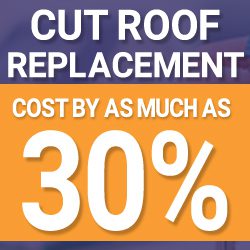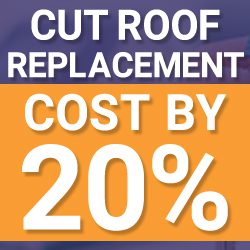
The Top 10 Signs You Need a Roof Repair
Roofs are our homes’ first line of defense against the elements, from the beating sun to torrential rain. Over time, even the most durable roof can face wear and tear. But how do you know if you just need a repair or a total roof replacement? Below, we dive into the top 10 signs indicating the need for a roof repair and highlight some common roofing problems you should be on the lookout for.
COMPARE QUOTES10 Common Roofing Problems and Signs You Need a Roof Repair
- Age of Your Roof: Most asphalt shingle roofs last about 20 to 25 years. If your roof is nearing this age, it’s wise to have a professional inspect it.
- Curled or Buckling Shingles: This is a sign that the shingles have reached their life expectancy. If the shingles are curling and buckling in areas that receive direct sunlight, it’s a signal they are past their prime.
- Missing Shingles: Wind, wildlife, or wear and tear can lead to shingles going missing, compromising the protective layer of your roof.
- Granules in Gutters: If your gutters are filled with granules, this means your roof is shedding its protective coating, and it might be time for a new one.
- Sagging Roof Deck: If you notice that the decking or rafters in the attic are sagging downward instead of remaining straight, they could be wet from leaking moisture.
- Daylight Through Roof Boards: If you see light coming through holes or cracks in the attic, it’s a clear sign of a roofing issue.
- Water Stains or Leaks in the Attic: After a heavy rainstorm, check your attic for any signs of water staining or leaks.
- Higher Energy Bills: A sudden increase in your energy bills might mean that warm or cool air is leaking through your roof.
- Moss and Algae Growth: Moss can look charming, but it holds moisture against the roof surface, which can damage the granules on the shingles.
- Roof Valleys: If shingles in the roof valleys are falling apart or missing, it’s a significant vulnerability since rainwater flows through valleys to the gutters.

Common Roofing Problems to Watch Out For
- Flashing Damage: Flashings are materials (usually metal) used to prevent water seepage at the joints or seams. Over time, these can become damaged or corroded, leading to leaks.
- Poor Installation: A poorly installed roof can lead to a multitude of problems, from leaks to reduced lifespan.
- Ventilation Issues: Proper attic ventilation prevents heat and moisture buildup, reducing the risk of ice dams or rot.
- Structural Damage: Heavy winds, fallen trees, or even repeated foot traffic can cause structural damage.
- Gutter Buildup: Clogged gutters can cause water to back up into the roof, leading to rot in the sheathing and rafters.
- Ice Dams: In colder climates, ice dams can form at the edge of roofs, preventing snow from draining off. The water that backs up can then leak into the home.
- Chimney or Skylight Flashing: The sealant used around chimneys or skylights can crack over time, leading to leaks.
- Ponding Water: Especially problematic for flat roofs, ponding water can lead to leaks and structural damage.
Maintaining your roof is crucial for the safety and efficiency of your home. Regular inspections and addressing small problems before they escalate can save homeowners significant time and money in the long run.
COMPARE QUOTESHow Much Can You Expect to Pay for a Roof Repair?
The cost of roof repairs can vary significantly based on the nature of the problem, the type of roofing material, the extent of the damage, and labor rates in your area. However, understanding the average costs can give homeowners an idea of what to anticipate when budgeting for a roof repair.
Factors Affecting the Cost
- Type of Roofing Material: Different materials have varied costs. For example, asphalt shingles might be less expensive than wood or slate shingles.
- Extent of Damage: A small leak repair will inevitably be less expensive than extensive damage covering a large area of the roof.
- Labor Rates: The cost of labor can fluctuate based on the region, the season, and the complexity of the job.
- Additional Materials: Beyond the primary roofing material, there might be a need for additional items such as nails, sealants, flashing, or underlayment, which can add to the overall cost.
- Accessibility: If the damaged area is hard to reach or if additional equipment is needed to access the roof safely, the cost might increase.

Average Cost of Roof Repairs
While the price range can be broad, on average:
- Minor repairs: For small leaks or localized damage, homeowners can expect to pay anywhere from $100 to $400.
- Moderate repairs: These might include repairing underlayments or larger sections of shingles, and the cost usually ranges from $400 to $1,000.
- Major repairs: If there’s extensive damage, perhaps due to a fallen tree or severe water leakage, the cost could be anywhere from $1,000 to $3,000.
- Complex issues: Situations like structural damage, replacing larger sections of the roof, or working with high-end materials can push repair costs even higher, sometimes exceeding $3,000.
However, it’s crucial to remember that these are general estimates. To get an accurate cost for your specific roof repair needs, it’s always best to consult with a local professional roofing contractor who can provide a detailed quote.
COMPARE QUOTESThe Value of Roof Repairs
While the upfront cost of repairing a roof can sometimes feel steep, it’s a crucial investment in your home’s overall health. Addressing roofing issues promptly can prevent more severe, more expensive problems down the road, including potential damage to your home’s interior or foundation. Moreover, a well-maintained roof can increase your property’s value, reduce energy costs, and give you peace of mind during adverse weather conditions.
While costs can vary, addressing roof issues promptly and professionally can save homeowners more significant expenses and headaches in the future. Regular inspections and understanding the signs of roof damage can aid in catching problems early and budgeting for necessary repairs.
How Long Does a Roof Last Before You Can Expect to See Problems?
A roof’s lifespan is one of the primary considerations for homeowners. Whether you’re purchasing a new home, contemplating a roof replacement, or just trying to gauge the longevity of your current roof, understanding the typical lifespans of various roofing materials can provide insight into when you might start to see problems. Let’s delve into the durability and expected life of different roofing materials.
Asphalt Shingles
Arguably the most common roofing material in the United States, asphalt shingles are known for their affordability and relatively easy installation. On average:
- 3-tab asphalt shingles can last between 15 to 20 years.
- Architectural asphalt shingles, which are thicker and more durable, have a lifespan of 25 to 30 years.
Factors like extreme weather conditions, poor ventilation, and inadequate roofing underlayment can shorten their lifespan.

Wooden Shingles and Shakes
Wooden shingles and shakes offer a classic and natural look to homes. With proper maintenance:
- Wooden shingles generally last about 20 to 30 years.
- Wooden shakes, being thicker, can last up to 35-40 years.
However, these materials can be susceptible to rot, insects, and mold, especially in damp climates. Regular maintenance and treatments can prolong their life.
Metal Roofing
Metal roofs are lauded for their durability and long life:
- A typical metal roof can last anywhere from 40 to 70 years, depending on the metal used and its thickness.
Metal roofs are resistant to extreme weather conditions, making them an excellent choice for areas prone to severe storms.
Slate, Clay, and Concrete Tiles
These materials are on the premium end of the roofing spectrum and are often chosen for their durability and distinctive look:
- Slate roofs can last an astonishing 75 to 100 years or more.
- Clay and concrete tiles generally have a lifespan of 50 to 100 years.
Though they have a long lifespan, they can be heavy and might require reinforced roof framing.
COMPARE QUOTESFlat Roofs
The lifespan of flat roofs depends heavily on the material used:
- EPDM (rubber) roofs typically last 20 to 25 years.
- PVC and TPO roofs have a lifespan of about 15 to 20 years.
Maintenance and periodic inspections are crucial for flat roofs, as they can be prone to leaks if not properly cared for.
Factors Affecting Roof Longevity
Apart from the material itself, various factors can impact how long a roof lasts:
- Installation: A correctly installed roof will invariably last longer than one that has been poorly installed.
- Ventilation: Proper ventilation can prevent moisture buildup, extending the roof’s lifespan.
- Maintenance: Regular inspections and timely repairs can stave off major problems and extend a roof’s life.
- Climate and Weather: Roofs in areas that face harsh weather conditions, be it extreme sun, heavy snowfall, or torrential rains, might wear out faster than those in milder climates.
While each roofing material has its typical lifespan, homeowners play a crucial role in ensuring their roof’s longevity through regular maintenance, prompt repairs, and understanding the specific needs of their chosen material. Knowing what to expect can help in budgeting for future repairs or replacements and ensure that your home remains protected for years to come.

Top Roof Maintenance Tips to Prevent the Need for Roof Repair
Roof maintenance might not be at the top of every homeowner’s list, but ensuring your roof remains in tip-top shape is one of the best ways to prevent costly repairs in the future. Proper roof care can significantly extend its lifespan, saving you time and money in the long run. Here are some tried-and-true roof maintenance tips that can keep your roof strong and resilient:
1. Regular Inspections
Twice a year, preferably in the spring and fall, do a visual inspection of your roof. Look for signs like broken or missing shingles, rusted flashing, and moss or algae growth. Such bi-annual checks can help identify and address potential issues before they exacerbate.
2. Clean Your Gutters
Clogged gutters can lead to water backup and damage to your roofing material. Ensure your gutters and downspouts are free from leaves, twigs, and other debris, especially after a storm or during fall when trees shed their leaves.
3. Remove Moss and Algae
Moss and algae can deteriorate roofing materials and might lead to leaks if not addressed. If you notice their growth, use a moss removal solution or hire a professional to clean the roof without causing damage.
4. Trim Overhanging Branches
Trees that hang over your roof can drop leaves, leading to rot, or even worse, branches could fall during storms. It’s always a good practice to trim branches that come too close to your roof.
5. Address Loose or Missing Shingles
After severe weather or just regular wear and tear, shingles can become loose or even go missing. Replace or repair these as soon as they’re spotted to prevent water damage and other underlying problems.
6. Check for Rust
If you have any metal on your roof, such as flashing or vents, inspect it periodically for rust. If you find any, wire brush the rust away, prime the area, and then paint to prevent further rusting.

7. Ensure Proper Ventilation
A well-ventilated attic helps in maintaining a balanced temperature on the roof, preventing issues like ice dams in the winter. It also ensures moisture doesn’t build up, preventing rot and mold growth.
8. Check Sealants and Flashing
Ensure that the sealants around roof penetrations (like vents or chimneys) remain intact. If they’re deteriorating, they’ll need to be replaced. Similarly, inspect the flashing for damage or signs of leakage and address any issues promptly.
9. Insulate the Attic
Proper attic insulation can prevent ice dams, a buildup of ice on the edge of the roof that can damage shingles and lead to leaks. Ensure your attic is adequately insulated to maintain a warm interior and prevent freezing on the roof during colder months.
10. Address Ice Dams
If you live in an area prone to heavy snowfall, watch out for ice dams. These occur when snow melts and then refreezes at the roof’s edge. Remove snow from your roof after storms, and consider installing a roof heat cable to melt ice during colder months.
Proactive roof maintenance can significantly delay the need for major repairs or replacements. By paying attention to the small details and addressing minor issues as they arise, you can ensure that your roof remains functional and aesthetically pleasing for many years. When in doubt, always consult with a professional roofer to assess the situation and provide guidance.
COMPARE QUOTES


Leave a Reply